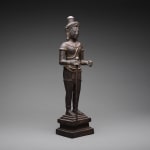Khmer Bronze Figure of Standing Shiva, 12th Century AD to 13th Century AD
Bronze
16.5 x 4 cm
6 1/2 x 1 5/8 in
6 1/2 x 1 5/8 in
PH.0204
Further images
This bronze figure of Shiva, one of the principal deities of Hinduism, dates to the 12-13th century and possibly earlier. Shiva is known as “The Destroyer” within the Trimurti, the...
This bronze figure of Shiva, one of the principal deities of Hinduism, dates to the 12-13th century and possibly earlier. Shiva is known as “The Destroyer” within the Trimurti, the Hindu trinity that includes Brahma and Vishnu. In Shaivism tradition, Shiva is one of the supreme beings who creates, protects and transforms the universe. The iconographical attributes of Shiva are the third eye on his forehead, the rosary beads in his hand, and the trishula or trident, as his staff shape weapon. Unlike most deities of Hinduism, Shiva is often depicted having a head and two arms.
This statuette of Shiva stands, holding a string of rosary in his left hand and a walking staff (or weapon) in his right hand. The deity is sumptuously adorned with elaborate jewellery, including a tiered multi- strand necklace, pendant earrings, arm bands and anklets. He wears a decorated Khmer-style headdress with the form of a high cylindrical chignon. He has a third eye on the middle of his forehead, along with undulating brow and a straight nose. His loincloth is very simple but adorned by prominent pendant belt. A single cord-like strand, which cuts across his chest, is probably a serpent. Shiva is often shown garlanded with a snake and the presence of the long, thin body of a snake allows for a conclusive identification of this image as Shiva.
This statuette of Shiva stands, holding a string of rosary in his left hand and a walking staff (or weapon) in his right hand. The deity is sumptuously adorned with elaborate jewellery, including a tiered multi- strand necklace, pendant earrings, arm bands and anklets. He wears a decorated Khmer-style headdress with the form of a high cylindrical chignon. He has a third eye on the middle of his forehead, along with undulating brow and a straight nose. His loincloth is very simple but adorned by prominent pendant belt. A single cord-like strand, which cuts across his chest, is probably a serpent. Shiva is often shown garlanded with a snake and the presence of the long, thin body of a snake allows for a conclusive identification of this image as Shiva.







